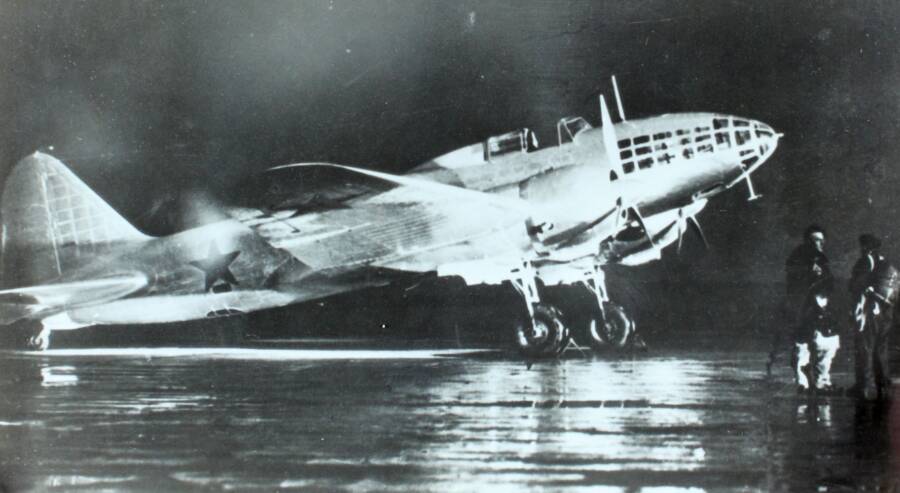Falling from an aircraft without a parachute seems to guarantee certain death. But not always.
Throughout the history of aviation, there have been several miraculous cases of people who survived falling from great distances.
Ball Turret Gunner Survives Fall From 22,000 Feet Without a Parachute
One such story is that of Staff Sergeant Alan Eugene Magee, a ball turret gunner on the B-17 bomber with the 360th Bomb Squadron, 303rd Bomb Group, in the US Army Air Corps during the Second World War. He survived a fall from 22,000 feet after his plane sustained damage over Saint Nazaire, France, on 3 January 1943.
During the mission, Magee’s B-17, nicknamed “Snap! Crackle! Pop!” was flying on a bombing mission with 85 other bombers to attempt to destroy the U-boat pens at Saint Nazaire. The pens were a frequent target for Allied bombers, but they never managed to take them out.

When they reached the target area, both flak and the guns from a German Messerschmitt Bf 109 struck “Snap! Crackle! Pop!” A flak hit tore off part of its right wing, and several bullets pierced the plexiglass of Magee’s ball turret.
The story of what happened next is not totally clear.
Several bullets or pieces of shrapnel may have struck Magee, damaging his parachute. Another account is that after being hit, he climbed out of the turret to get his chute and found it damaged and unusable. During all this, a large hole opened in the side of the fuselage, and the bomber began to spiral downward.

Next, Magee was either ejected from the damaged plane or jumped, losing consciousness during his nearly four-mile fall to earth, unable to recall the exact events. At the same time, onlookers in the city below initially mistook him for a bomb.
German Provided Quality Care for Magee After Long Fall
Magee crashed into the glass roof of the Saint Nazaire train station, and his body hung limply from the twisted metal girders. Again, reports are uncertain, with some saying he ended up on the station floor.
Finding him somehow still alive, German soldiers got him down and took him to a German doctor. Magee had suffered massive injuries. These included 28 shrapnel wounds, a broken nose, a ripped-off eyelid, a punctured lung and kidneys, broken teeth, a broken right leg and ankle, as well as a right arm almost torn out of his torso. The soldiers took him to a local hospital.
“I owe the German military doctor who treated me a debt of gratitude,” said Magee. “He told me, ‘We are enemies, but I am first a doctor, and I will do my best to save your arm.'”
According to Magee, the Germans treated him well during his two-and-a-half-month hospitalization. However, he was eventually sent to a POW camp until the end of the war. He never learned the name of that doctor who first cared for him.
Physics Helps Magee Survive
Knowing how he survived his fall is impossible, but physics may have helped. The 5 feet 6 inches, 155-pound Magee would have reached a terminal velocity of about 120 miles per hour and fell for approximately two minutes. Therefore, he probably struck the roof at a slower speed than some people in plane or even automobile crashes. Magee eventually recovered from his injuries and lived until the age of 84.
British Aviator Only Suffers Twisted Knee After Falling from 18,000 Feet
Magee was not the only World War II aviator to survive a long fall. On 23 March 1944, Nicholas Alkemade, a tail gunner in a British Lancaster bomber, fell from 18,000 and lived. His aircraft was on a night bombing mission to Berlin when German fighters attacked, setting it on fire. The pilot ordered the crew to bail out.

Alkemade discovered that his parachute was burning. Instead of staying with the aircraft, he decided to jump out. During the fall, he said he remained conscious and thought about dying and relaxed his body. He landed in an area with tall trees and drifted snow. Unbelievably, he only had a twisted knee and a few cuts.
Russian Pilot Loses Consciousness Before Opening Chute
Russian Lieutenant Ivan Mikhailovich Chisov was another aviator who survived a fall without a parachute. In January 1942, his Ilyushin IL-4 bomber was attacked and damaged by German fighters. Chisov bailed out at 21,980 feet and allowed himself to free fall to avoid being hit by the Germans. He planned to open his parachute at 1,000 feet but lost consciousness.

He hit a steep slope with several feet of snow and slid to the bottom. Chisov suffered a fractured pelvis and a bruised spine but lived. He recovered quickly and returned to the cockpit in less than four months.
Flight Attendant Sets Record for Longest Fall
Despite these military accounts of surviving falls without parachutes, a civilian, Vesna Vulović, may have the record for living after the longest fall. On 26 January 1962, she was a flight attendant on a Yugoslav Airlines DC-9 flying from Stockholm, Sweden to Belgrade, Yugoslavia. Croatian terrorists had planted a bomb on the jet, and it exploded at 33,300 feet.

Vesna Vulović, trapped in the tail section of the DC-9 as it plummeted to Earth, survived the crash in a snow-covered forest, sustaining two broken legs and temporary paralysis from the waist down. After 27 days in a coma, she awoke and, following a 17-month recovery, regained sensation in her legs and learned to walk again, though with a limp.

These are just a few examples of people who survived long falls without parachutes. There are other similar stories. For instance, US Airmen Olen Cooper Bryant, Arthur Frechette, and Paddy McGarry lived after falling from high altitudes during the Second World War.
